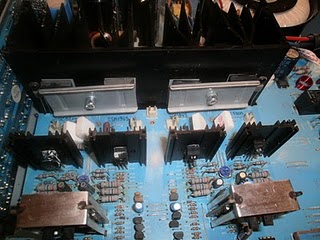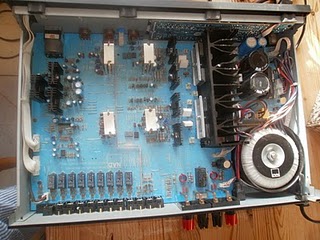
A NAD C355BEE integrated amplifier came into us for repair last week, with the customer reporting that the amp would remain in standby at all times - this is a common fault when the output stages have been destroyed, usually by short circuit load or high volume use for prolonged period (thermal runnaway).

Having got hold of the circuit diagram, it was easy to diagnose the problem armed with just a continuity tester - the PNP output transistor on the right channel was short circuit from collector to emitter, which had then blown the DC power supply fuses. His caused the output voltage of that channel to be stuck hard against the negative power supply rail. The TO126 package transistors mounted on the smaller black heatsinks are driver stage transistors, and checking these, the one that drives the failed output device was also short circuit. Removing this transistor was tricky, as NAD mount 3 transistors back to back on this one heatsink - presumably for good thermal tracking and stability, or maybe also for ease of manufacture.
With the two faulty transistors replaced, and after carefully checking the circuit board for any solder bridges where the repairs had been needed, it was time for testing! Rather than power up via the NAD's own power supply (which carries the risk of uncontrolled current flow if something is still amiss), the amp was powered using a current limited, adjustable voltage regulated power supply, gradually ramping from 0 volts up to about plus/ minus 30V. The output voltage of the repaired channel now sat at 100mV, which is absolutely normal. The amp was then re-biassed and soak tested for 24 hours.